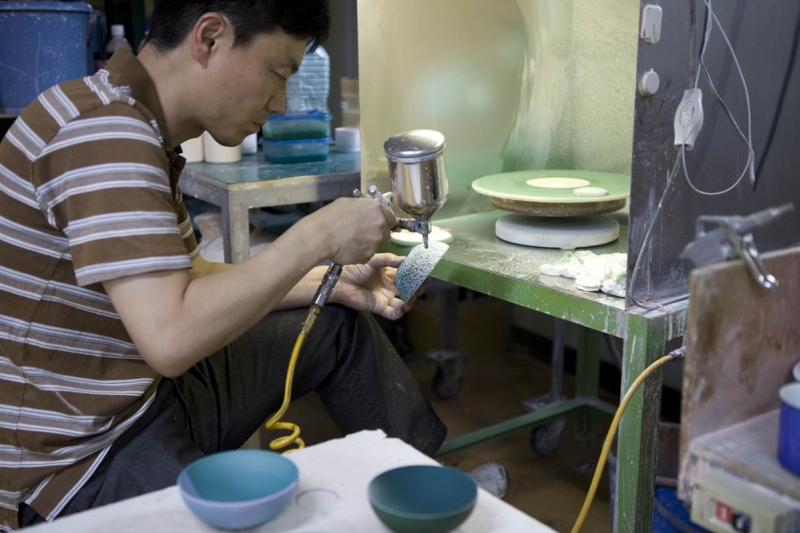Interview: Mr. Mizokami, Kouemongama
The Kouemon company was founded in Arita in the 19th century. Throughout its history, the pottery has developed characteristic styles of making, typically these involve the use of Sometsuke (a blue underglaze technique) and Somenishiki (an overglaze on top of Sometsuke). However, as is common with the 2016/ project, new challenges have been handed to the Kouemon pottery. Here Mr. Mizokami talks to us about overcoming them and mastering complicated new techniques.
- Many of the vessels being produced by Kouemon seem to have especially thin walls – is this a feature of your work?
These objects have been developed specifically for Japanese restaurants. The thin walls make the vessels light and therefore it is easier to carry many objects at the same time. We’ve even considered the noise the porcelain makes when it is stacked and have reduced the ‘noisiness’ of the porcelain objects moving against each other. This attention to detail and the resulting techniques are highly appreciated by our clients.
- Your factory is part of the group ‘10C Collective Kiln’ which is a collaboration of 10 different workshops in Arita who rent individual spaces and share a large communal kiln. How has this facility influenced how you work?
Sharing the facility with other makers has reduced the burden of capital investment for our company. And there is also an atmosphere of collaboration between the workshops, we share ideas. Knowing what others are doing allows us to retain our individuality; we don’t follow the trends of our fellow makers, if we did so the market would be filled with the same product, instead the benefit of such an insight is that we can focus on new challenges that are individual to us.
- How is your work for 2016/ developing?
Our pottery has been evolving the technique of overglazing for many years. Overgalzed items are our best selling products and most of our employees are overglaze craftsmen and women. However, for 2016/, we have decided to work on creating porcelain products that have different wall thickness – the technicques we are now dedicating ourselves to aren’t about overglazing at all. It is stretching our technology and our knowledge.
- It is technically difficult to achieve porcelain items that have a thick base but thin walls. How are you achieving this technique?
The biggest worry is not firing, but molding. For example, when making vessels with 22mm thickness on the base and 4mm thickness on the edge, the thicker part is unable to dry. Furthermore, it will then be fired at high temperatures of 1300 ºc. In the prototype stage, that thick bases exploded in the kiln. We’ve learnt the thicknesses that can be achieved by trial and error. Sometimes I have been confused by the designer's requests, but the prototyping and development stages of the projects have seen many people involved and together we have found solutions. In particular, the trading company has been invloved and offered support. The 2016/ product has established a new relationship between trading company and Arita makers.










